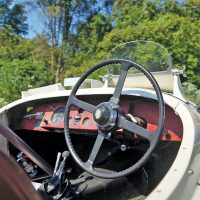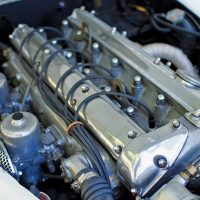SCM Analysis
Detailing
| Vehicle: | 1950 Jaguar XK 120 Competition Roadster |
| Years Produced: | 1950–54 (steel cars) |
| Number Produced: | 7,391 (roadsters) |
| Original List Price: | $3,000 |
| SCM Valuation: | Median to date, $119,000; high sale, $574,804 |
| Chassis Number Location: | Tag riveted to firewall |
| Engine Number Location: | On head between cams |
| Club Info: | Jaguar Club of North America |
| Website: | http://www.jcna.com |
This car, Lot 235, sold for $82,500, including buyer’s premium, at Bonhams’ auction in Philadelphia, PA, on October 3, 2016.
Today’s profile presents an interesting challenge: Frequently, one of my primary purposes is to explain why an old racing car sold for so much money. Today the challenge is reversed — I have to try to understand why this Jaguar didn’t sell for much, much more than it did.
Let’s start by looking at the concept of value in collector cars. Generally, market value for any car can be seen as a reflection of how “special” it is, what makes it different from — and more desirable to own than — something else that would be available for less money. It can be power, beauty, brand, condition, historical importance, associations with celebrity, the stories it could tell or simple lust, but as a general approach, the more factors a car has to make it special, the more valuable it is.
Specialness is, of course, related to whatever it is that characterized a marque; Model J Duesenbergs were associated with wealth and celebrity, so Clark Gable’s Duesie has more collector value than a similar one originally owned by a banker from Peoria.
Likewise, performance and racing marques frequently look to racing history to differentiate the important from the ordinary, but it can get complicated. I frequently discuss the differing importance of “weapons grade” (go out and win) factors and “collector grade” factors in any old racing car.
Once a disposable weapon
It is important to remember that every racing car was first produced as a 100% weapon for battle, and it was valued only insofar as it was competitive. These cars were utterly disposable. When its serious racing days were over, a car had to present some other value, or it would be simply thrown away. Some kept racing at a lower, now a vintage, level; some went back to being road cars; some were put away for sentimental or aesthetic reasons, and a substantial number of them were junked.
Collector value came along later, as the concept of vintage car racing gained ground in the United States, and the generation of kids who grew up hanging on the fence at racetracks in the 1950s and 1960s accumulated spending money.
While weapons value is arguably objective (you can quantify finishing order or even fun), collector value is completely subjective — it is pretty much whatever a group of people thinks it should be. As such, collector value can be very inconsistent depending on how a given car is perceived. This can be a problem for cars that can be either collectible treasures or weapons-grade vintage racers (or both).
A groundbreaking car
Introduced in the late 1940s, Jaguar’s XK 120 took the automotive world by storm. It was light, fast, sleek, sexy, thoroughly modern, and relatively affordable. It was a paradigm shift in what sporting automobiles could be. It was the first great production sports car of the post-war years.
For the first two or three years of its existence, the XK 120 was virtually unassailable on the racetracks of the world. As its competitors struggled to catch up, the XK 120 and its slightly evolved sister, the XK 140, remained a force in racing through the 1950s.
The XK 120 is by far the most collectible of 1950s Jaguars, with good steel-bodied roadsters generally bringing between $130,000 and $200,000. Good racing history and preparation should add $25,000 to $50,000 on top of that, which means that today’s subject car sold for between half and a third of what it would be expected to bring.
What is wrong here?
The short answer is that I don’t know, nor does anyone with whom I have discussed this sale. The previous time it sold was at Bonhams’ Monterey sale in 2005, for $46,000, about the same fraction of what good street ones sold for then as what happened this time, so it doesn’t appear to be a fluke.
What may have happened
Let’s run through the various possibilities. The car could be in horrible shape, but there are extensive photographs with the catalog that suggest it is at least pretty good to very nice, so I don’t think that is the case.
Given the extensive racing use over the years, it is unlikely that the engine is numbers-matching, and it obviously has incorrect (two-inch E-type) carburetors, but it is difficult to assign much value loss to that. Correct carburetors are easy to source, and the original engine isn’t as important for old British racers as for Italian ones.
The catalog clearly states that FIA papers come with it, so the mechanical configuration (suspension, brakes, driveline) can be safely presumed to be correct.
Ownership history from new, early race records and period photographs are included, which should quiet any questions about provenance.
In short, none of the obvious reasons for it to have been so cheap seem to apply. This only leaves one reasonable hypothesis: perception.
I discussed earlier that racing cars all start with only weapons value, but many accrue subjective collector value over time. One of the problems with vintage racing cars in the United States is that they are frequently seen as only having weapons value for racing.
Even the best XK 120 is pretty old, slow and clumsy to be competitive in the catch-all grids in most United States vintage races. In this environment, a Sprite may well outrun it. Eighty grand is probably a fair number if that is all you are thinking about.
In Europe, they take their racing more seriously, and the grids are larger and more carefully defined, so an XK 120 has a lot of similar cars to run against. Also, racing history is more important to the owners, so cars like this are more highly valued.
Although Bonhams is a top-notch international operation, the Philadelphia sale was pretty obscure (none of my European friends had followed it), and the catalog description made little effort to describe the car as other than an old vintage racer. My guess is that it was sold for local weapons-grade value rather than its international value.
Whoever bought it made a very intelligent — or lucky — investment. It was very well bought. ♦
(Introductory description courtesy of Bonhams.)


